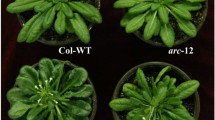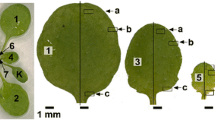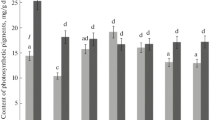Abstract
Photosynthetic cells of most land plant lineages have numerous small chloroplasts even though most algae, and even the early diverging land plant group the hornworts, tend to have one or a few large chloroplasts. One constraint that small chloroplasts could improve is the resistance to CO2 diffusion from the atmosphere to the chloroplast stroma. We examined the mesophyll conductance (inverse of the diffusion resistance) of mutant Arabidopsis thaliana plants with one or only a few large chloroplasts per cell. The accumulation and replication of chloroplasts (arc) mutants of A. thaliana were studied by model fitting to gas exchange data and 13CO2 discrimination during carbon fixation. The two methods generally agreed, but the value of the CO2 compensation point of Rubisco (Γ *) used in the model had a large impact on the estimated photosynthetic parameters, including mesophyll conductance. We found that having only a few large chloroplasts per cell resulted in a 25–50 % reduction in the mesophyll conductance at ambient CO2.








Similar content being viewed by others
References
Ahmadabadi M, Bock R (2012) Plastid division and morphology in the genus Peperomia. Biol Plant 56:301–306
Atkin OK, Evans JR, Ball MC, Lambers H, Pons TL (2000) Leaf respiration of snow gum in the light and dark. Interactions between temperature and irradiance. Plant Physiol 122:915–924
Austin J II, Webber AN (2005) Photosynthesis in Arabidopsis thaliana mutants with reduced chloroplast number. Photosynth Res 85:373–384
Barbour MM, McDowell NG, Tcherkez G, Bickford CP, Hanson DT (2007) A new measurement technique reveals rapid post-illumination changes in the carbon isotope composition of leaf-respired CO2. Plant Cell Environ 30:469–482
Bernacchi CJ, Singsaas EL, Pimentel C, Portis AR Jr, Long SP (2001) Improved temperature response functions for models of Rubisco-limited photosynthesis. Plant Cell Environ 24:253–259
Bernacchi CJ, Portis AR, Nakano H, Von Caemmerer S, Long SP (2002) Temperature response of mesophyll conductance. Implications for the determination of Rubisco enzyme kinetics and for limitations to photosynthesis in vivo. Plant Physiol 130:1992–1998
Bickford CP, McDowell NG, Erhardt EB, Hanson DT (2009) High-frequency field measurements of diurnal carbon isotope discrimination and internal conductance in a semi-arid species, Juniperus monosperma. Plant Cell Environ 32:796–810
Brooks A, Farquhar GD (1985) Effects of temperature on the O2/CO2 secificity of ribulose-1,5-bisphosphate carboxylase/oxygenase and the rate of respiration in the light. Estimates from gas exchange measurements on spinach. Planta 165:397–406
Busch FA, Sage TL, Cousins AB, Sage RF (2013) C3 plants enhance rates of photosynthesis by reassimilating photorespired and respired CO2. Plant Cell Environ 36:200–212
Crumpton-Taylor M, Grandison S, Png KMY, Bushby AJ, Smith AM (2012) Control of starch granule numbers in Arabidopsis chloroplasts. Plant Physiol 158:905–916
Erhardt EB, Hanson DT (2013) tdllicor: TDL/Licor Processing. R Package Version 0.1-22
Ethier GJ, Livingston NJ (2004) On the need to incorporate sensitivity to CO2 transfer conductance into the Farquhar-von Caemmerer-Berry leaf photosynthesis model. Plant Cell Environ 27:137–153
Evans JR, Von Caemmerer S (2013) Temperature response of carbon isotope discrimination and mesophyll conductance in tobacco. Plant Cell Environ 36:745–756
Evans JR, Sharkey TD, Berry JA, Farquhar GD (1986) Carbon isotope discrimination measured concurrently with gas exchange to investigate CO2 diffusion in leaves of higher plants. Aust J Plant Physiol 13:281–292
Evans JR, Von Caemmerer S, Setchell BA, Hudson GS (1994) The relationship between CO2 transfer conductance and leaf anatomy in transgenic tobacco with a reduced content of Rubisco. Aust J Plant Physiol 21:475–495
Farquhar GD, Von Caemmerer S, Berry JA (1980) A biochemical model of photosynthetic CO2 assimilation in leaves of C3 species. Planta 149:78–90
Flexas J et al (2006) Tobacco aquaporin NtAQP1 is involved in mesophyll conductance to CO2 in vivo. Plant J 48:427–439
Flexas J, Diaz-Espejo A, Galmés J, Kaldenhoff R, Medrano H, Ribas-Carbo M (2007a) Rapid variations of mesophyll conductance in response to changes in CO2 concentration around leaves. Plant Cell Environ 30:1284–1298
Flexas J, Ortuño MF, Ribas-Carbo M, Diaz-Espejo A, Flórez-Sarasa ID, Medrano H (2007b) Mesophyll conductance to CO2 in Arabidopsis thaliana. New Phytol 175:501–511
Graham LE, Wilcox LW (2000) Algae. Prentice Hall, Upper Saddle River
Griffiths H, Helliker BR (2013) Mesophyll conductance: internal insights of leaf carbon exchange. Plant Cell Environ 36:733–735
Gu L, Sun Y (2014) Artefactual responses of mesophyll conductance to CO2 and irradiance estimated with the variable J and online isotope discrimination methods. Plant Cell Environ 37(5):1231–1249
Hanson DT, Renzaglia K, Villarreal JC (2014) Diffusion limitation and CO2 concentrating mechanisms in bryophytes. In: Hanson DT, Rice SK (eds) Photosynthesis in bryophytes and early land plants. Advances in photosynthesis and respiration, vol 37. Springer, Dordrecht, pp 95–111. doi:10.1007/978-94-007-6988-5_6
Harley PC, Loreto F, Di Marco G, Sharkey TD (1992a) Theoretical considerations when estimating the mesophyll conductance to CO2 flux by analysis of the response of photosynthesis to CO2. Plant Physiol 98:1429–1436
Harley PC, Thomas RB, Reynolds JF, Strain BR (1992b) Modelling photosynthesis of cotton grown in elevated CO2 Plant. Cell Environ 15:271–282
Heckwolf M, Pater D, Hanson DT, Kaldenhoff R (2011) The Arabidopsis thaliana aquaporin AtPIP1;2 is a physiologically relevant CO2 transport facilitator. Plant J 67:795–804
Jeong WJ, Park Y-I, Suh K, Raven JA, Yoo OJ, Liu JR (2002) A large population of small chloroplasts in tobacco leaf cells allows more effective chloroplast movement than a few enlarged chloroplasts. Plant Physiol 129:112–121
Jones HG, Slatyer RO (1972) Estimation of the transport and carboxylation components of the intracellular limitation to leaf photosynthesis. Plant Physiol 50:283–288
Laisk A (1977) Kinetics of photosynthesis and photorespiration of C3 plants (in Russian). Nauka, Moscow
Lanigan GJ, Betson N, Griffiths H, Seibt U (2008) Carbon isotope fractionation during photorespiration and carboxylation in Senecio. Plant Physiol 148:2013–2020
Li Y, Ren BB, Ding L, Shen QR, Peng SB, Guo SW (2013) Does chloroplast size influence photosynthetic nitrogen use efficiency? PLoS One 8(4):e62036
Loreto F, Harley PC, Di Marco G, Sharkey TD (1992) Estimation of mesophyll conductance to CO2 flux by three different methods. Plant Physiol 98:1437–1443
Morita MT, Nakamura M (2012) Dynamic behavior of plastids related to environmental response. Curr Opin Plant Biol 15:722–728
Osteryoung KW, Pyke KA (2014) Division and dynamic morphology of plastids. Annu Rev Plant Biol 65:443–472
Possingham JV, Saurer W (1969) Changes in chloroplast number per cell during leaf development in spinach. Planta 86:186–194
Psaras GK, Diamantopoulos GS, Makrypoulias CP (1996) Chlopoplast arrangement along intercellular air spaces. Isr J Plant Sci 44:1–9
Pyke KA (1999) Plastid division and development. Plant Cell 11:549–556
Pyke KA, Leech RM (1992) Chloroplast division and expansion is radically altered by nuclear mutations in Arabidopsis thaliana. Plant Physiol 99:1005–1008
Pyke KA, Leech RM (1994) A genetic-analysis of chloroplast division and expansion in Arabidopsis thaliana. Plant Physiol 104:201–207
Pyke KA, Rutherford SM, Robertson EJ, Leech RM (1994) arc6, a fertile Arabidopsis mutant with only 2 mesophyll cell chloroplasts. Plant Physiol 106:1169–1177
Samsuddin Z, Impens I (1979) Photosynthesis and diffusion resistances to carbon dioxide in Hevea brasiliensis muel. agr. clones. Oecologia 37:361–363
Scafaro AP, von Caemmerer S, Evans JR, Atwell BJ (2011) Temperature response of mesophyll conductance in cultivated and wild Oryza species with contrasting mesophyll cell wall thickness. Plant Cell Environ 34:1999–2008
Sharkey TD (2012) Mesophyll conductance: constraint on carbon acquisition by C3 plants. Plant Cell Environ 35:1881–1883
Sharkey TD, Vassey TL, Vanderveer PJ, Vierstra RD (1991) Carbon metabolism enzymes and photosynthesis in transgenic tobacco (Nicotiana tabacum L.) having excess phytochrome. Planta 185:287–296
Sharkey TD, Bernacchi CJ, Farquhar GD, Singsaas EL (2007) Fitting photosynthetic carbon dioxide response curves for C3 leaves. Plant Cell Environ 30:1035–1040
Takagi S (2003) Actin-based photo-orientation movement of chloroplasts in plant cells. J Exp Biol 206:1963–1969
Terashima I, Miyazawa S-I, Hanba YT (2001) Why are sun leaves thicker than shade leaves? —Consideration based on analyses of CO2 diffusion in the leaf. J Plant Res 114:93–105
Tholen D, Boom C, Noguchi KO, Ueda S, Katase T, Terashima I (2008) The chloroplast avoidance response decreases internal conductance to CO2 diffusion in Arabidopsis thaliana leaves. Plant Cell Environ 31:1688–1700
Tholen D, Boom C, Zhu X-G (2012) Opinion: prospects for improving photosynthesis by altering leaf anatomy. Plant Sci 197:92–101
Uehlein N, Otto B, Hanson DT, Fischer M, McDowell N, Kaldenhoff R (2008) Function of Nicotiana tabacum aquaporins as chloroplast gas pores challenges the concept of membrane CO2 permeability. Plant Cell 20:648–657
Villar R, Held AA, Merino J (1995) Dark leaf respiration in light and darkness of an evergreen and a deciduous plant species. Plant Physiol 107:421–427
von Caemmerer S, Evans JR (1991) Determination of the CO2 pressure in chloroplasts from leaves of several C3 plants. Aust J Plant Physiol 18:287–305
Wada M (2013) Chloroplast movement. Plant Sci 210:177–182
Walker B, Ariza LS, Kaines S, Badger MR, Cousins AB (2013) Temperature response of in vivo Rubisco kinetics and mesophyll conductance in Arabidopsis thaliana: comparisons to Nicotiana tabacum. Plant Cell Environ 36:2108–2119
Warren CR (2008) Stand aside stomata, another actor deserves centre stage: the forgotten role of the internal conductance to CO2 transfer. J Exp Bot 59:1475–1487
Warren C, Dreyer E (2006) Temperature response of photosynthesis and internal conductance to CO2: results from two independent approaches. J Exp Bot 57:3057–3067
Yoder DW, Kadirjan-Kalbach D, Olson BJSC, S-y Miyagishima, DeBlasio SL, Hangarter RP, Osteryoung KW (2007) Effects of mutations in Arabidopsis FtsZ1 on plastid division, FtsZ ring formation and positioning, and FtsZ filament morphology in vivo. Plant Cell Physiol 48:775–791
Acknowledgments
We thank Dr. Katherine Osteryoung for providing the arc mutant seeds and for thoughtful discussions throughout the project. This work was supported by DOE grant DE-SC0008509 to TDS and NSF grant IOS-0719118 and NIH grant NIH-NCRR P20RR18754 to DTH. Partial salary support for TDS comes from Michigan State University AgBioResearch.
Author information
Authors and Affiliations
Corresponding author
Electronic supplementary material
Below is the link to the electronic supplementary material.
Rights and permissions
About this article
Cite this article
Weise, S.E., Carr, D.J., Bourke, A.M. et al. The arc mutants of Arabidopsis with fewer large chloroplasts have a lower mesophyll conductance. Photosynth Res 124, 117–126 (2015). https://doi.org/10.1007/s11120-015-0110-4
Received:
Accepted:
Published:
Issue Date:
DOI: https://doi.org/10.1007/s11120-015-0110-4




